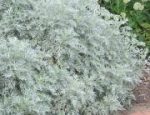 Artemesia is a genus of woody and herbaceous perennials and includes several well known plants such as tarragon, sagebrush, mugwort, and wormwood. It is a member of the aster family, Asteraceae, that also includes daisy, sunflower, and lettuce, and is native to Asia, Europe, and North America. Plants may be tall and erect or small and mounding and range in size from 6″ to 6′. Most have small gray-green to silver leaves that are lobed or dissected and are aromatic when crushed. Inconspicuous yellowish gray male and female discoid flower heads grow on different plants in loose terminal clusters late in summer and add nothing to the plants’ ornamental appearance. The genus name, Artemesia, honors the Greek goddess who of wild animals, the hunt, chastity, and childbirth.
Artemesia is a genus of woody and herbaceous perennials and includes several well known plants such as tarragon, sagebrush, mugwort, and wormwood. It is a member of the aster family, Asteraceae, that also includes daisy, sunflower, and lettuce, and is native to Asia, Europe, and North America. Plants may be tall and erect or small and mounding and range in size from 6″ to 6′. Most have small gray-green to silver leaves that are lobed or dissected and are aromatic when crushed. Inconspicuous yellowish gray male and female discoid flower heads grow on different plants in loose terminal clusters late in summer and add nothing to the plants’ ornamental appearance. The genus name, Artemesia, honors the Greek goddess who of wild animals, the hunt, chastity, and childbirth.
Most artemesias are native to dry areas and are very drought tolerant. They grow best in average, moderately moist to dry, very well-drained soil and full sun and do poorly in hot humid areas. Fertilizers encourage spindly growth and should be avoided. Shrubby forms can be pruned hard to rejuvenate them when necessary. Herbaceous species can be propagated by division in fall or spring, or by cuttings in in late summer. Shrubby species can also be propagated in late summer by cuttings taken from new shoots with a piece of old wood attached. Exuberant species such as A. lactiflora and A. ludoviciana should be divided every 2-3 years to restrain them.
Artemesia are grown primarily for their silvery foliage that serves as a good foil for bright colors. Low growing species can be used in rock gardens or as edgers and ground covers a while taller ones are useful in borders.
The following Artemesias are recommended for the garden:
Old-Man/Southernwood/ Lad’s Love (A. 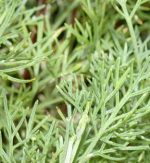 abrotanum)
abrotanum)
Place where fragrance can be appreciated when foliage is touched.
Type: Erect, branching subshrub
Height: 3-4′
Leaves:Gray-green, finely divided, 1.5-2.5″ long
Hardiness: Zones 5-8
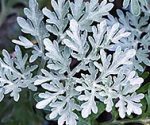 Common Wormwood (A. absinthium)
Common Wormwood (A. absinthium)
Best known for its importance in the preparation of the drink absinthe. Outstanding selection is ‘Lambrook Silver’
Type: Erect, woody well branched subshrub
Height: 2-4′
Leaves: Silver-gray, hairy, 1.5-4″ pinnately dissected
Hardiness: Zones 3-9
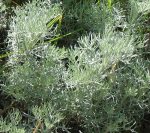 Artemsia alba ‘Canescens’
Artemsia alba ‘Canescens’
Type: Open, mounding subshrub
Height: 12-18″
Leaves: Silvery-gray, finely divided, 1/2-1″ long
Hardiness: Zones 4-8
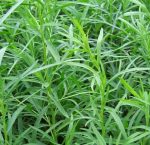 Tarragon (A. dracunculus)
Tarragon (A. dracunculus)
Culinary herb as well an garden ornamental
Type: Herbaceous perennial with open habit
Height: 2-5′
Leaves: Green, lanceolate, 4-6″ long
Hardiness: Zones 3-8
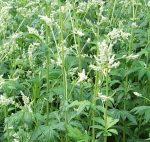 White Mugwort (A. lactiflora)
White Mugwort (A. lactiflora)
The different one with green foliage, conspicuous flowers, and a need for moist soil. Late summer cream white flowers appear in 1-2′ long plume like panicles.
Type: Herbaceous perennial
Height: 4-6′
Leaves:Bright green broad, deeply divided leaves, 6-8″ long
Hardiness: Zones 4-9
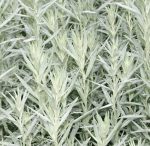 White Sage (A. ludoviciana)
White Sage (A. ludoviciana)
Native to North america; outstanding cultivars are ‘Silver King’, Silver Queen’ and ‘Valerie Finnis’; tolerates warm temperatures.
Type: Compact herbaceous perennial
Height: 2-4′
Leaves: Silvery, deciduous, entire, woolly underside, lanceolate, 4-6″ long
Hardiness: Zones 3-9
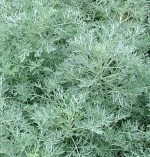 A. x ‘Powis Castle’
A. x ‘Powis Castle’
Hybrid between A. absinthum and A arborescens
Type: Compact subshrub
Height: 2-3′
Leaves:Silvery white feathery, deeply cut, 1-3″ long
Hardiness: Zones 5-8
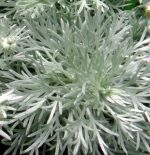 Silvermound Artemisia (A. schmidtiana)
Silvermound Artemisia (A. schmidtiana)
Fabulous looking but melts out in areas with warm summer temperatures. Species not usually seen but cultivar ‘Nana’ (aka ‘Silver Mound’) readily available.
Type: Subshrub with mounding habit
Height: 1-2′
Leaves:Silvery silky-haired, finely divided, densely crowed, 1.75″ long
Hardiness: Zones 3-7
Beach Wormwood (A. stellerana)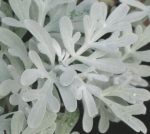
Outstanding cultivar is ‘Silver Brocade’ with its dense mat of prostrate foliage; good choice for seaside gardens
Type: Subshrub with low spreading habit
Height: 1.5-2.5′
Leaves:Densely felted with white hairs, coardely lobed, ovate to oblong, 2-4″ long
Hardiness: Zones 3-8